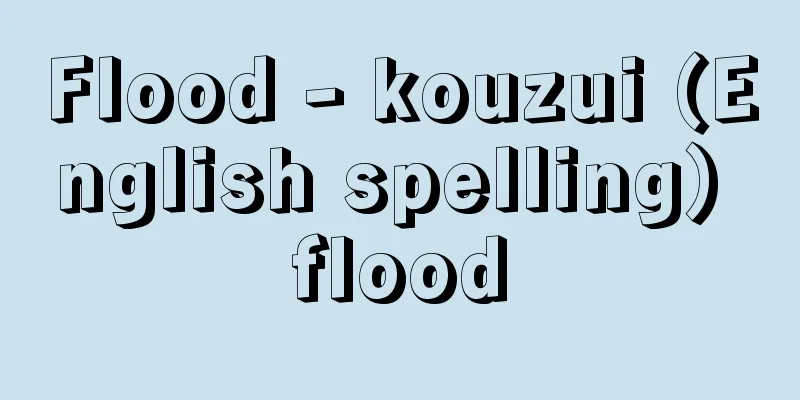Flood - kouzui (English spelling) flood

|
This is the phenomenon in which a large amount of water flows into a river when heavy rain falls in the river basin or when snow on the mountains melts in the spring. This can damage revetments, overflow levees, or even destroy the levees, causing damage to the coastline; this is called flood damage. [Takao Ando and Yoh Nomura] Flood damageThe main meteorological causes of flooding are heavy rains caused by fronts and typhoons during the warm season (from around June to September), and snowmelt in early spring is also a cause, but does not cause floods as severe as the former. Japan receives more rain than other mid-latitude countries, and because the mountains are close to the sea, rivers are short and have steep gradients, so rain from the mountains flows into the plains in a short time and causes flooding. For this reason, the country suffers relatively a lot of damage from floods. Furthermore, of all meteorological disasters in Japan, floods cause the greatest damage in terms of both human casualties and material damage. This is because most of Japan's plains are alluvial plains formed by river flooding, and about 50% of the country's population and about 70% of its resources are concentrated there. [Takao Ando and Yoh Nomura] History of flood controlThe earliest record of flood control of rivers in Japan is from around the first half of the 5th century, when a new river was excavated downstream of the Yodo River in Osaka to divert the waters of the Yamato River and the Manda Levee was built on the left bank of the Yodo River to protect the districts of Katano, Matata, and Higashinari (present-day Hirakata, Neyagawa, Moriguchi, and other areas of the Kitakawachi plains) from flooding. However, during the Yayoi period, which preceded this, rice cultivation was introduced and rice became the mainstay of the economy. At first, rice paddies for producing rice used small rivers and springs in the valleys on the mountainside, but as the population grew and rice production was forced to increase, they had no choice but to expand near the main stream of the river. It can be said that this was the period when the struggle against floods invading rice paddies began. Rivers have a dual nature: they nourish rice in paddy fields, but on the other hand, they destroy the fields when they flood. The Ibaraki embankment is thought to be an early record of the time when Japan, which had become a unified nation, carried out large-scale projects to ensure rice production. The method used to build the Ibaraki embankment is unclear, but since many of the Hata clan, who were naturalized people at the time, were involved in this work, it is believed that flood control techniques from Baekje and even Chinese flood control methods were used. If the legend that Yu ruled over the Yellow River is true, then China's flood control dates back to around 2300 BC. China has a long history of flood control, and the technology is thought to have been quite advanced. The idea behind flood control was that it was impossible to prevent floods by simply building levees, and that rivers should be controlled by understanding the nature of the river well and using methods that would offer the least resistance to its flow. It seems that the idea of flood control in Japan was also based on this Chinese idea of flood control until around the mid-Edo period. In the Nara period, the Mikuni River (present-day Kanzaki River) was excavated by diverting the lower reaches of the Yodo River, and the levees of the Kinu River (Tochigi Prefecture), Tenryu River (Nagano and Shizuoka Prefectures), and Yodo River were also repaired. When the capital was moved to Kyoto, flood control of the Kamo River (Kamagawa River, Kyoto Prefecture) naturally began, and people in charge of flood control appear in history under the title Bokashi. However, although there are traces of the development of ring levees on the Katsura River (Kyoto Prefecture) and the Yodo River, no major flood control projects were carried out after that. It was during the Sengoku period that flood control works were actively undertaken again, with famous examples being Takeda Shingen's flood control of the Kamanashi River, Toyotomi Hideyoshi's diversion of the Kiso River course, and the separation of Oguraike Pond and the Uji River. In the Edo period, river diversions (also called segae) were increasingly carried out in various places. However, in the early modern civil engineering works, methods such as the construction of ring embankments around specific villages, cultivated land, or castle towns were used to protect them from flooding, and so-called low-water works were carried out to allow rivers to flow freely outside the embankments. Furthermore, the Norigoetei embankment, which is said to have been the first to be constructed by Kato Kiyomasa on the Kikuchi River in Higo (Kumamoto) during the Tensho era (1573-1592), as well as other structures such as the Karigane embankment, Araiseki, and double embankments, and the Kasumitei embankment, which is said to have been constructed by Shingen, were all embankment methods that stored the water between the embankments or intentionally allowed it to spill into the land inside the embankment when the water level rose above a certain level, and there was no thought of confining the river between the embankments. Therefore, it seems that the aforementioned Chinese idea of flood control was influential in Japanese flood control up to this time. When the Tokugawa clan entered the Kanto region, they worked on flood control of the Tone River and the Arakawa River, which had been turbulent up until that point. The Tone River was then excavated further and further east, eventually diverting into the Kinu River in Hitachi, and forming the current course for Choshi. The Ina clan, who were the magistrates of this project, used low-water construction methods such as setting up flood control basins and building double banks, but also used high-water construction methods such as building continuous banks, which were a major advance over previous civil engineering techniques. This was due to the development of high-water construction techniques to raise the levees, as well as the development of revetments and water control techniques, but it was also due to the development of Japanese mathematics, which became the basis for these techniques and made it possible to calculate the volume of embankments and the ratio of the top and bottom surfaces. At the time, these techniques were considered secrets of each school, and the Ina clan was one of the schools with the most outstanding techniques. Then, in the middle of the Edo period, around the Kyoho era (1716-1736), embankment technology had advanced further, and it became possible to build embankments that could withstand high water. Due to the need for land development and utilization, "river protection (flood prevention)" came to mean preparations to prevent embankments from breaking, and the idea of flood control changed to confining rivers within a series of high embankments to contain floods. Other developments in bank protection and water control technology included gabions (made of long, round woven bamboo or wisteria vines stuffed with stones, shaped like a snake), frames (wooden pyramids shaped like triangular pyramids called "seigyu" because of their resemblance to ox horns), and tsutsumi (projecting embankments) that jut out into the river roughly parallel to the embankment. Furthermore, advances in mining technology, such as excavation of rocks, also contributed to this trend. The shift to high-water construction methods was inevitable as economic and social development progressed, and was an unavoidable direction. However, this resulted in rapid river flows, sediment accumulating in the riverbed, and the riverbed becoming higher. To prevent this, levees had to be made higher and stronger. There was much debate after the Meiji era began before dams were introduced as flood control, but it can be said that flood control works were the mainstream in Japan. [Takao Ando and Yoh Nomura] Current flood control and flood controlModern flood control is dominated by the multipurpose dam method, which involves building dams in mountainous areas of rivers to regulate floods and also use them for water utilization. In essence, the dams are used to stop floods that occur during warm seasons, control floods downstream, and use the stored water for agricultural irrigation and hydroelectric power generation on a regular basis. Flood control using dams in Japan was proposed at the end of the Taisho era, and the Ikari Dam (Tochigi Prefecture) was constructed on the Kinugawa River. However, it was not until 1949 (Showa 24) after World War II that dams began to be used for multipurpose purposes. The impetus for this was the reflection on the previous high-water construction work using large continuous levees following the successive occurrence of major flood damages caused by Typhoon Kathleen in 1947 and Typhoon Ion in 1948, as well as the rapid increase in demand for electricity, industrial water, and even urban water due to the development of industry. Needless to say, the success of the Tennessee River basin development by the American TVA (Tennessee Valley Authority) was also a major inspiration. However, flood control of rivers cannot be achieved by dams alone. In particular, there are no dams in Japan that have a large enough capacity to block floods. The main purpose is to adjust the amount of water during floods over time and gradually reduce the size of the flood waves, thereby preventing temporary, destructive outflows of water into rivers. To achieve this, levees are constructed, flood retention basins are installed, and levees and river regulating structures are laid, so that comprehensive flood control can be achieved, including adjustment of the amount of water during floods (designated flood volume). [Takao Ando and Yoh Narumura] Flood forecastThere are two types of flood forecasts: those issued by the Japan Meteorological Agency for general use, and those issued jointly by the Japan Meteorological Agency and river administrators for specific rivers for the purpose of flood prevention activities. The Japan Meteorological Agency issues flood advisories when there is a risk of heavy rainfall, rivers rising and flooding causing damage, and flood warnings when there is a risk of "serious flood damage." The criteria for issuing a flood warning vary for each forecast district, but for example, in the case of Yokohama City (as of May 2010), a flood warning is issued when one-hour rainfall of 30 millimeters or more is predicted, and the basin rainfall index is 16 or more in the Sakaigawa basin, 14 or more in the Kashio River basin, 6 or more in the Katabira River basin, 8 or more in the Onda River basin, or 15 or more in the Aratama River basin; and a flood alert is issued when one-hour rainfall of 45 millimeters or more is predicted, and the basin rainfall index is 20 or more in the Sakaigawa basin, 18 or more in the Kashio River basin, 8 or more in the Katabira River basin, 10 or more in the Onda River basin, or 19 or more in the Aratama River basin. Flood forecasts for specific rivers also forecast the water levels and flow rates at specific points on the river, and the results are notified to the prefectures concerned by the Meteorological Agency and the river administrators in cooperation with the media as necessary, and are made known to the general public for use in various flood prevention activities. Specifically, the titles of flood forecasts and the names of water levels are divided into the following five levels according to the risk of flooding. (1) Level 5 (Title: Flood Information, Status: Flood) The trigger for the start of flood forecasts that specify rivers was the collapse of the Tone River levees near Kurihashi in Saitama Prefecture caused by Typhoon Kathleen, which passed over the Boso Peninsula from the sea south of the Kii Peninsula on September 15, 1947 (Showa 22), and the muddy torrent that flowed south affected almost 100% of Katsushika Ward in Tokyo, 67% of Edogawa Ward, and 11% of Adachi Ward. After that, facilities and systems were improved, and by 1962, 17 rivers were included in the forecast, and the Japan Meteorological Agency and the Ministry of Construction (now the Ministry of Land, Infrastructure, Transport and Tourism) jointly carried out flood forecasts that specified rivers. However, the number of designated rivers had not increased beyond 17 by 1988. This is because these 17 rivers are relatively easy to forecast flooding due to the fact that (1) they are mainly among the major rivers in Japan with large drainage areas, and observation facilities for rainfall and water level have been established from early on, and (2) the time between precipitation in the upstream basin and flooding in the downstream basin is long, making it possible to issue practical flood forecasts. However, this does not mean that there was no risk of flooding for rivers other than the 17. Although progress was made in river repairs for major rivers, and the number of levee breaches and flooding decreased, major damage occurred, such as the collapse of the Tama River levee in Komae City, Tokyo, due to the heavy rains of Typhoon No. 16 in September 1974, and frequent floods occurred in the Kokai River (Tochigi Prefecture), Ishikari River (Hokkaido), and Chikuma River (Nagano Prefecture). For this reason, the Ministry of Construction established a river management system, and the Japan Meteorological Agency has been working to improve forecasting technology, such as short-term precipitation forecasts. Short-term precipitation forecasts were particularly useful for flood forecasting for rivers where the time between rainfall and flooding is short, and for rivers with small drainage basins. For these reasons, the Ministry of Construction and the Japan Meteorological Agency decided to expand precipitation forecasts to specific rivers, starting with the Tama River in 1988, and gradually designating all first-class rivers across the country. The Japan Meteorological Agency and the Ministry of Land, Infrastructure, Transport and Tourism jointly conduct flood forecasts for all 109 first-class river systems (river systems that are particularly important in terms of land conservation or the national economy and designated by government ordinance). In addition, prefectures and the Japan Meteorological Agency will begin joint flood forecasts for rivers managed by prefectures from 2002, and plans are underway to gradually expand this system. [Takao Ando and Yoh Nomura] "Disaster Prevention Science Series 1: Meteorological Disasters" edited by Hatakeyama Hisanao (1966, Kyoritsu Shuppan)" ▽ "Stories of Heavy Rain" by Ninomiya Kozo (1977, Idemitsu Shoten)" ▽ "Modern Meteorological Technology 3: Disaster Prevention and Weather" by Miyazawa Seiji (1982, Asakura Shoten)" ▽ "Heavy Rain and Flood Disaster Prevention" edited by Takahashi Hiroshi, Kinoshita Takeo, Uehara Shigeji, Fujita Hisao, Komatsu Shoichi, and Yamaguchi Takashi (1987, Hakua Shobo)" ▽ "The History of Rivers in Floods and Flood Control: From Controlling Flood Damage to Accepting It" by Okuma Takashi (1988, Heibonsha) ▽ "Fighting with Raging Rivers" by Takahashi Yutaka and illustrated by Fujita Masazumi (1989, Rural Culture Association)" ▽ "Stories of Floods: Experiences of Flood Victims from Around Japan from the 1980s to the 1990s" edited and published by the Japan River Association (1991) ▽ "The Climate of Flood Control Thought - From Early Modern Times to the Present," by Ito Yasuo (1994, Kokin Shoin) ▽ "Floods and America - Floodplain Management of the Mississippi River," edited by the American River Study Group (1994, Sankaido) ▽ "Floods of the Tone River - Passing on the History of the Basin," edited by the Tone River Study Group (1995, Sankaido) ▽ "Fighting Disasters 4: Floods," by Jane Walker, translated by Tachibana Takayuki (1996, Kaiseisha) ▽ "Floods," by Paul Bennett, supervised translation by the Japanese Red Cross Society and translated by the Tokyo Foreign Language Center (1999, Komine Shoten) ▽ "Nature and Culture of Mountains and Rivers - Slash-and-burn Culture of the Akaishi Mountains and Floods of Tokai-type Rivers," by Matsumoto Shigeki (2000, Daimeido) ▽ "Ryozo Yorimitsu (ed.), "Environmental Protection of River Basins: Forests, Rivers, Seas, and People" (2001, Nihon Keizai Hyoronsha) " "Disaster Prevention Research Institute, Kyoto University (ed.), "Disaster Prevention Studies Course 1: Wind and Flood Disasters" (2003, Sankaido)" [References] | | | | Ishikari | | | | | Typhoon Kathleen | | River | | Katsura | River | Kamo | | Kikuchi River | | | River | | | Kobai | | | Flood control | River | | | | | | | River | Tone | | | | | | fireSource: Shogakukan Encyclopedia Nipponica About Encyclopedia Nipponica Information | Legend |
|
河川の流域に大雨が降ったり、山の積雪が春に融(と)けたりして、河川に多量の水が流出してくる現象をいう。このため、護岸施設を破損したり、さらには堤防を越えたり、あるいは堤防を破壊した水が沿岸に被害を与えるが、これを洪水害という。 [安藤隆夫・饒村 曜] 洪水害洪水をおこす気象的な原因は、暖候期(6月から9月ごろまで)の前線や台風に伴う大雨が主で、春先の融雪もその原因ではあるが、前者ほど大きな洪水を伴うことはない。日本は他の中緯度の国に比べて雨が多く、山地が海に迫っているために河川の長さは短く、勾配(こうばい)が急で、山地の雨は短時間に平野部に流れ出てきて氾濫(はんらん)する。このため洪水の被害は比較的多い国である。また日本の気象災害のなかでは、洪水による被害は、人的被害においても物的被害においても、もっとも大きな災害をもたらす。それは、日本の平野は大部分が河川の氾濫によってできた沖積平野であり、そこに全人口の約5割、全資源の約7割が集中していることに原因がある。 [安藤隆夫・饒村 曜] 治水の歴史日本における河川の治水のもっとも早い記録は、5世紀前半ごろに、現在の大阪の淀川(よどがわ)下流に新川を開削して大和(やまと)川の水を分流させるとともに、淀川の左岸に茨田堤(まんだのつつみ)を築き、交野(かたの)、茨田(まった)、東成(ひがしなり)(現在の枚方(ひらかた)、寝屋川、守口など北河内(きたかわち)の平野)の各郡を、淀川の氾濫から守ったという事績がある。しかし、それより先の弥生(やよい)時代に稲作が伝えられ、米が経済の主体になってから、米を生産する水田は、初めは山際の谷地田(やちた)の小河川や湧水(ゆうすい)を利用していたが、人口が増え米の生産の増強が迫られるにつれて、河川の主流近くにまで拡張せざるをえなくなる。この時期から水田を侵す洪水との闘いが始まったといえる。河川は水田の稲を養う母である反面、洪水時には水田を荒らすという両面性をもっている。茨田堤は、統一国家となった日本が、米の生産力の確保のために大規模な事業を行ったころの初期の記録と思われる。茨田の築堤の方式はさだかではないが、当時の帰化人である秦氏(はたうじ)の多くがこれにあたったというところから、百済(くだら)の治水技術、さらには中国の治水の方式なども利用されたと思われる。 中国の治水は、禹(う)が黄河を治めたとの伝承が真実とすれば、紀元前2300年ごろにさかのぼる。中国の治水の歴史は古く、その技術もかなり進歩していたと思われる。その治水の思想は、いたずらに堤防をもって洪水を防ごうとしてもそれは不可能であって、よく河の性質を知り、その流れにもっとも抵抗の少ない方法により、河を治めるべきであるとするものであった。日本における治水思想も、江戸中期ごろまで、根底にこの中国の治水の考え方があったように思われる。 奈良時代に入ってからは、淀川の下流を分流させて三国川(現、神崎(かんざき)川)を開削したほか、鬼怒(きぬ)川(栃木県)、天竜川(長野・静岡県)、淀川の堤防の修築などを行っている。都が京都に移ると、賀茂(かも)川(鴨(かも)川、京都府)の治水が始まったのは当然として、治水の担当者が防鴨河使(ぼうかし)などと称して史上に現れてくる。しかしその後、桂(かつら)川(京都府)や淀川に輪中堤(わじゅうてい)などの発達の跡はみられるが、大きな治水事業は行われていない。治水事業がふたたび活発に行われるようになったのは戦国時代からで、武田信玄(たけだしんげん)の釜無(かまなし)川の治水や、豊臣秀吉(とよとみひでよし)の木曽(きそ)川の河道の付け替え、巨椋池(おぐらいけ)と宇治川の分離などは有名である。江戸時代に入るとますます河川の付け替え(瀬替(せがえ)ともいう)などが各地で行われるようになる。しかし近世の土木工事は、その初期には、特定の村落や耕地あるいは城下を洪水から守るために、周囲に堤を設ける輪中などの方法がとられ、河川はその堤外を自由に流下させるいわゆる低水(ていすい)工事が行われた。また天正(てんしょう)年間(1573~1592)加藤清正が肥後(ひご)(熊本)の菊池川で初めて行ったとされる乗越堤(のりごえてい)や、そのほか雁金堤(かりがねてい)、洗堰(あらいせき)、二重堤にしても、また信玄が実施したといわれる霞堤(かすみてい)なども、一定の水嵩(みずかさ)以上に水位が上昇すれば、堤間にこれを蓄えるか、または堤内地へ意図的に溢出(いっしゅつ)させる築堤方式であり、河川を堤間に閉じ込めようとする考えはなかった。したがって、このころまで日本の治水の思想には、前述の中国の治水の思想が流れていたと思われる。 徳川氏が関東に入り、それまでほとんど乱流を繰り返していた利根(とね)川や荒川の治水を手がけた。そして利根川は東へ東へと開削され、ついに常陸(ひたち)の鬼怒川にこれを放ち、現在の銚子(ちょうし)への流路とするのであるが、これを奉行(ぶぎょう)した伊奈(いな)氏の手法には、遊水池を設け、二重堤を築くなど低水工事がみられる反面、連続堤を築くなど高水(こうすい)工事の手法もみられ、それ以前の土木技術に比べて大きな進歩がみられる。これは、堤防を高くする高水工事や、その護岸や水制の技術の発展によるが、さらにその基礎として和算の発達があり、これによって築堤の体積や、上面と底面の割合などの計算が可能となったためといわれる。当時これらの技術は各流派の秘伝とされ、伊奈氏などもっとも卓越した技術をもった流派の一つであった。そして江戸時代の中期、享保(きょうほう)年間(1716~1736)のころになると、築堤技術はさらに進み、高水によく耐える築堤が建造できるようになる。土地の開拓や利用上の必要もあって「川除(かわよけ)(水防)とは堤を切らさぬ備え」となり、連続した高堤の中に河川を閉じ込め、洪水もその中に治めるようにする高水工事の思想に変わっていくのである。また堤防を強化する蛇籠(じゃかご)(タケや藤づるなどを丸く長軸に編んでなかに石を詰めたもので、形がヘビに似ている)、枠(木を三角錐(さんかくすい)に組んだものは、その形がウシの角(つの)に似ているため聖牛(せいぎゅう)などとよばれる)、河川のなかに堤防とほぼ平行して突き出している出し堤(つつみ)などの護岸、水制の技術も発達していった。さらに、鉱山技術の発達による岩石の掘り抜き工事などの進歩もこれを促進したといえよう。高水工法への移行は経済社会の発展に伴う必然的なことで、やむをえない方向ではあったと思う。しかし、この結果として、河川は急流となり、土砂は河床にたまり、河床は高くなり、これを防ぐためには、ますます堤防を高くじょうぶにしていかなければならなかった。 その後明治時代を迎え、ダムによる治水が導入されるまでいろいろと論議はあったが、高水工事が日本の治水の主流であったといえよう。 [安藤隆夫・饒村 曜] 現在の治水・洪水調節現代の治水は、河川の山間部にダムをつくり、ダムによって洪水を調整し、他面これを利水の面にも利用しようとする多目的ダムによる方法が主流といえよう。要は、暖候期に発生する洪水をダムによってせき止め、下流の洪水を制御するとともに、農業用水、水力発電などにその貯水を定常的に利用しようとするものである。日本におけるダムによる洪水調節は大正時代末期に提唱され、鬼怒川に五十里ダム(いかりだむ)(栃木県)の建設が図られている。しかし、ダムが本格的に多目的な期待を担って登場するのは、第二次世界大戦後の1949年(昭和24)以降である。その契機となったのは、1947年のカスリーン台風や1948年のアイオン台風による大水害の相次ぐ発生に伴う、従来の連続大堤防の築造による高水工事への反省とともに、利水上は工業の発展に伴う電力、工業用水、さらには都市用水の需要の急激な増加などであった。またアメリカのTVA(Tennessee Valley Authorityの略。テネシー川流域開発公社のこと)のテネシー河川流域の開発の成功なども大きな刺激であったことはいうまでもない。 しかし河川の治水は、ダムのみによって洪水調節を図りうるものではない。とくに日本のダムには、洪水を遮断するほどの容量の大きいものはない。洪水時の水量を時間的に調節し、洪水波の山をなし崩しに小さくすることにより、河川に一時的、破壊的な水量が流出するのを避けることがおもな目的である。そのために、堤防を構築し遊水池を設け、堤防の護岸と河川の水制などを敷き、洪水時の水量(計画洪水量)の調節もできるよう、総合的な洪水調節に向かっている。 [安藤隆夫・饒村 曜] 洪水予報洪水予報には、気象庁が発表する一般の利用を目的としたものと、気象庁と河川管理者が共同で発表する、水防活動を目的とし河川を指定した洪水予報の2種類がある。気象庁では、多量の雨が降り、河川が増水して洪水による水害がおこるおそれがあるときは洪水注意報を、また「重大な水害」がおこるおそれがあるときは洪水警報を発表している。発表基準は、各予報区ごとに異なるが、たとえば横浜市の場合(2010年5月時点)、1時間雨量が30ミリメートル以上、流域雨量指数が境川(さかいがわ)流域16以上、柏尾(かしお)川流域14以上、帷子(かたびら)川流域6以上、恩田(おんだ)川流域8以上、新田間(あらたま)川流域15以上のいずれかが予想されるときには洪水注意報を、1時間雨量が45ミリメートル以上、流域雨量指数が境川流域20以上、柏尾川流域18以上、帷子川流域8以上、恩田川流域10以上、新田間川流域19以上のいずれかが予想されるときには洪水警報を発表する。 河川を指定した洪水予報は、その河川の特定地点の水位や流量をも予報するもので、その予報結果は、気象庁と河川管理者が共同で関係都道府県に通知するとともに、必要に応じて報道機関の協力を求めて一般に周知し、各種の水防活動に使われている。具体的には、洪水予報の標題と水位の名称を、洪水の危険に応じて以下の五つのレベルに分けている。 (1)レベル5(標題:はん濫発生情報、状態:はん濫発生) 河川を指定した洪水予報が始まるきっかけとなったのは、1947年(昭和22)9月15日に紀伊半島の南海上から房総半島をかすめたカスリーン台風によって、利根川の堤防が埼玉県栗橋(くりはし)付近で決壊、南下した濁流は、東京都葛飾(かつしか)区ではほぼ100%、江戸川区では67%、足立(あだち)区では11%を被災者にした水害が発生したことによる。その後、設備や制度等が整備され、1962年までに17河川が対象となり、気象庁と建設省(現、国土交通省)が共同で河川を指定した洪水予報を行ってきた。しかし、1988年までに指定した河川の数は17から増えなかった。これは、この17河川が、(1)流域面積が大きい日本有数の河川が中心であり、早くから雨量や水位等の観測施設が整備されてきた、(2)上流域での降水から下流域での出水までの時間が長い、などのことから、洪水予報が比較的行いやすい河川であったために実用性のある洪水予報が出せたからであり、17河川以外が洪水の心配がなかったわけではない。主要な大河川については、河川の改修等が進み、破堤や氾濫などは減少していったが、1974年9月に台風第16号の豪雨によって東京都狛江(こまえ)市の多摩川堤防が決壊したり、小貝(こかい)川(栃木県)、石狩(いしかり)川(北海道)、千曲(ちくま)川(長野県)などではたびたび洪水になったりするなど、大きな被害が発生していた。このため、建設省は河川管理システムを整備し、気象庁は降水短時間予報等の予測技術の向上を図ってきた。とくに降水短時間予報は、降雨から河川の出水までの時間の短い河川や、流域面積の小さい河川の洪水予報に対して有効な情報であった。これらのことから、建設省と気象庁は河川を指定した降水予報を拡大することとし、1988年の多摩川を皮切りに、全国の一級河川を順次指定し、109ある一級水系(国土保全上、または国民経済上とくに重要な水系で政令で指定したもの)すべてで、気象庁と国土交通省が共同で洪水予報を行っている。また、都道府県管理の河川についても、2002年(平成14)からは、都道府県と気象庁が共同で行う洪水予報が始まるなど、順次拡大が計画されている。 [安藤隆夫・饒村 曜] 『畠山久尚編『防災科学シリーズ1 気象災害』(1966・共立出版)』▽『二宮洸三著『集中豪雨の話』(1977・出光書店)』▽『宮沢清治著『現代の気象テクノロジー3 防災と気象』(1982・朝倉書店)』▽『高橋博・木下武雄・植原茂次・藤田寿雄・小松章一・山口高志編『豪雨・洪水防災』(1987・白亜書房)』▽『大熊孝著『洪水と治水の河川史――水害の制圧から受容へ』(1988・平凡社)』▽『高橋裕著、藤田正純絵『あばれ川とたたかう』(1989・農山漁村文化協会)』▽『日本河川協会編・刊『大水のはなし 全国の洪水被災者の体験談'80~'90』(1991)』▽『伊藤安男著『治水思想の風土――近世から現代へ』(1994・古今書院)』▽『米国河川研究会編著『洪水とアメリカ――ミシシッピ川の氾濫原管理』(1994・山海堂)』▽『利根川研究会編『利根川の洪水――語り継ぐ流域の歴史』(1995・山海堂)』▽『ジェーン・ウォーカー著、橘高弓枝訳『災害とたたかう4 洪水』(1996・偕成社)』▽『ポール・ベネット著、日本赤十字社監訳、東京外国語センター訳『洪水』(1999・小峰書店)』▽『松本繁樹著『山地・河川の自然と文化――赤石山地の焼畑文化と東海型河川の洪水』(2000・大明堂)』▽『依光良三編著『流域の環境保護――森・川・海と人びと』(2001・日本経済評論社)』▽『京都大学防災研究所編『防災学講座1 風水害論』(2003・山海堂)』 [参照項目] | | | | | | | | | | | | | | | | | | | | | | | | | | | | | | | | | | | | | | | | | |出典 小学館 日本大百科全書(ニッポニカ)日本大百科全書(ニッポニカ)について 情報 | 凡例 |
>>: Hard water - Kousui (English spelling)
Recommend
Stone hugging - Ishidaki
〘 noun 〙 One of the prison methods used in the Edo...
Hedera rhombea (English spelling) Hederarhombea
…[Hiroshi Aramata]. … *Some of the terminology th...
Society
...In Mongolia, which is next to the south, it is...
Nine stages of rebirth
This refers to the nine stages (kubon) of rebirth ...
Official - Yakunin
〘noun〙① A person with a role. A person who takes o...
Irreducible fraction formula - Irreducible fraction formula
... are some examples. When the numerator and den...
Kakitani Temple
…The survey book for 1248 (Hōji 2) shows that Hir...
Occupational Safety and Health - roudou anzen eisei
An occupational accident is an injury, illness, or...
Fuuko - Fuko
This was one of the compensation systems for aris...
shuttle-loop transit
...Monorails can also be considered a type of rai...
Rhodope Mountains - Rhodope
A mountain range stretching from southwestern Bulg...
"Voices in the Choir"
…After his release in 1971, he was not allowed to...
Cryptochiton stelleri (Large stone turtle shell) - Cryptochiton stelleri
A mollusc of the Chiton class and family Cootidae ...
Wave current
…Submerged breakwaters, which are installed below...
Sea crucian carp - Sea crucian carp
…It is found in areas south of central Honshu, Ta...









